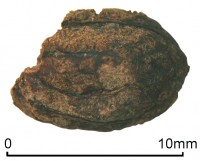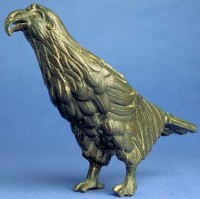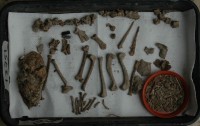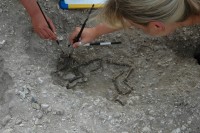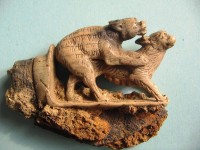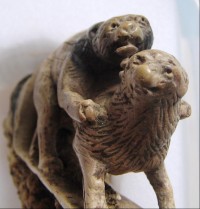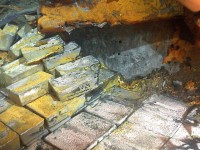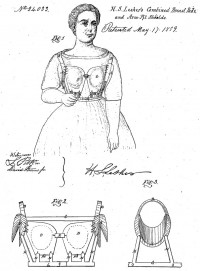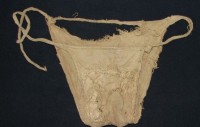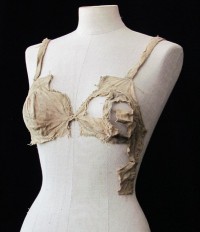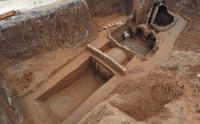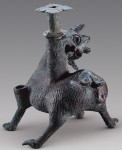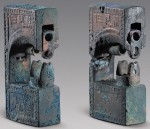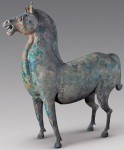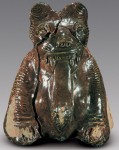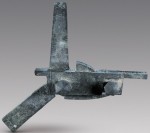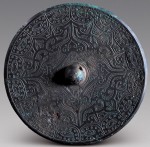 A Zapotec tomb with a unique vertical structure has been discovered in the Oaxacan archeological site of Atzompa. The three-chambered funerary complex is 1100 years old and is unlike any other Zapotec tombs discovered thus far. It was built above ground, one chamber on top of the other, whereas all other Zapotec tombs discovered to date have been under the floors of houses and palaces. Also, one of the burial chambers has some richly colored murals that refer to the Mesoamerican ballgame. Zapotec ball courts have been found before, but these are the first wall paintings with a ballgame motif discovered in a Zapotec tomb.
A Zapotec tomb with a unique vertical structure has been discovered in the Oaxacan archeological site of Atzompa. The three-chambered funerary complex is 1100 years old and is unlike any other Zapotec tombs discovered thus far. It was built above ground, one chamber on top of the other, whereas all other Zapotec tombs discovered to date have been under the floors of houses and palaces. Also, one of the burial chambers has some richly colored murals that refer to the Mesoamerican ballgame. Zapotec ball courts have been found before, but these are the first wall paintings with a ballgame motif discovered in a Zapotec tomb.
Atzompa was founded in the Late Classic period (650-900 A.D.) as a satellite city of the Zapotec center of Monte Albán. According to the National Institute of Anthropology and History (INAH) press release on the find, the unique architecture and artistic motifs of this tomb suggest that Atzompa didn’t just duplicate the culture of Monte Albán, but developed their own forms of cultural expression.
 No human remains have been discovered so far (one of the three chambers has yet to be opened), but archaeologists believe the burial chambers must have been constructed for important personages because the complex is adjacent to the House of the Altars, a home for the town’s elite who probably had connections to the mother city of Monte Albán.
No human remains have been discovered so far (one of the three chambers has yet to be opened), but archaeologists believe the burial chambers must have been constructed for important personages because the complex is adjacent to the House of the Altars, a home for the town’s elite who probably had connections to the mother city of Monte Albán.
The first chamber is about eight feet wide, six feet high and 15 feet deep with a vaulted ceiling. It was created with large stone slabs placed over stone walls that bear the remains of stucco decoration. It appears to have been deliberately filled in with earth and stone in antiquity.
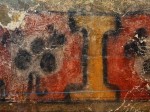 The second chamber is 15 feet deep and just one square meter tall and wide. The roof is flat, made from stone slabs, and the walls are covered with murals frescoed over a thin stucco layer. These are the paintings depicting the ballgame. They are abstract — no human figures playing ball are depicted — but the yellow shapes that look like a capital I represent the ball court. The small white circles covered with squiggles represent the game in play. The large white circles with the black outline are probably representations of the pelota, i.e., the ball. The smallest back wall — the center when you’re looking at the chamber from the entrance — has been damaged. Archaeologists speculate that area might have contained the name of the person buried in the tomb.
The second chamber is 15 feet deep and just one square meter tall and wide. The roof is flat, made from stone slabs, and the walls are covered with murals frescoed over a thin stucco layer. These are the paintings depicting the ballgame. They are abstract — no human figures playing ball are depicted — but the yellow shapes that look like a capital I represent the ball court. The small white circles covered with squiggles represent the game in play. The large white circles with the black outline are probably representations of the pelota, i.e., the ball. The smallest back wall — the center when you’re looking at the chamber from the entrance — has been damaged. Archaeologists speculate that area might have contained the name of the person buried in the tomb.
 The ballgame had ritual significance in every Mesoamerican civilization which played it. It was used to solve boundary disputes, as a proxy for war. The Maya linked the game to human sacrifice, playing rigged ritual ballgames where the pre-ordained losers would be sacrificed, sometimes even sacrificing professional players. Ball courts were thus literal portals to the underworld as well as figurative ones, where the eternal cosmological struggle between life and death, dark and light, good and evil, was played out over and over.
The ballgame had ritual significance in every Mesoamerican civilization which played it. It was used to solve boundary disputes, as a proxy for war. The Maya linked the game to human sacrifice, playing rigged ritual ballgames where the pre-ordained losers would be sacrificed, sometimes even sacrificing professional players. Ball courts were thus literal portals to the underworld as well as figurative ones, where the eternal cosmological struggle between life and death, dark and light, good and evil, was played out over and over.
It makes sense that the game would appear in a funerary context, therefore, and indeed it has in a number of Mesoamerican cultures. The Oaxacan Zapotecs, however, depicted priests and priestesses performing rituals or people accompanying the deceased to the underworld in their funerary paintings. It’s only this one tomb that features the allegorical ballgame motif.
 Archaeologists also found an offering in the second chamber consisting of small pottery vessels, a turtle bone, an engraved turtle shell, a fragment of shell that they think was the eye of a sculpture or death mask, a jade bead and a miniature metate (a mealing stone or mortar). The third chamber has only been observed through a small opening at this point, but archaeologists have seen a partial roof canopy and some murals. Excavation of this chamber is about to begin.
Archaeologists also found an offering in the second chamber consisting of small pottery vessels, a turtle bone, an engraved turtle shell, a fragment of shell that they think was the eye of a sculpture or death mask, a jade bead and a miniature metate (a mealing stone or mortar). The third chamber has only been observed through a small opening at this point, but archaeologists have seen a partial roof canopy and some murals. Excavation of this chamber is about to begin.
As the first chamber indicates, it seems this tomb complex was intentionally damaged in antiquity. Experts think it was a ritual destruction performed when the city was abandoned at the end of the period, between 850 and 900 A.D. after the collapse of Monte Albán power. The Zapotecs would have seen this as the end of a cycle, and since important buildings were seen as having a life of their own, they would be emptied and cancelled out to properly close the cycle.
So far only INAH experts have worked on the site. Going forward, they will enlist Harvard scientists to analyze the artifacts. The pottery and animal remains will be radiocarbon dated. The paint in the murals will be sampled so the pigments can be identified.
